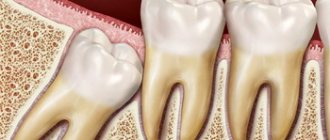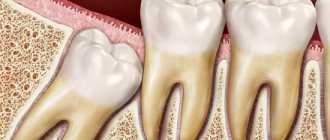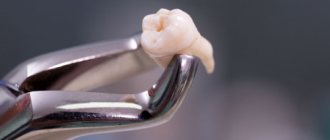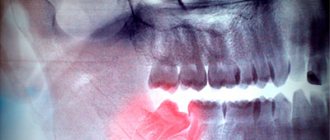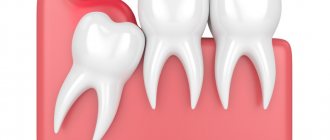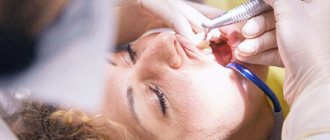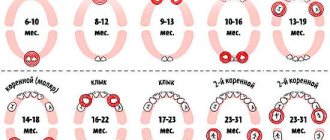01.12.2019
My child’s teeth have started to grow crooked, what should I do? How to solve the problem with milk and permanent curved row. Modern corrective orthodontic systems.
If a child’s tooth grows crookedly, then this is not only a cosmetic problem. A malocclusion can affect the health of the oral cavity and the digestive system. Bite correction must begin at an early age. At the same time, baby and permanent teeth need to be treated for curvature.
A child’s first teeth – and already crooked? Why
When a baby’s first teeth are crooked, parents don’t know what to do, whether it’s dangerous or not. Only a pediatric dentist can answer this question. After the examination, he will advise what measures need to be taken. In any case, you should not panic; it is recommended to pay attention to the following factors:
- if there are even spaces between the teeth, then it is possible to naturally correct the position of the growing units
- unequal gaps indicate shifts in tooth spacing and can lead to deformation of the permanent row
- Do not hope that after crooked baby teeth fall out, the permanent ones will be straight, this may not happen
The reasons for the formation of curvature of the first teeth are the lack of solid food, training of the chewing reflex, diseases of the nasopharynx, heredity, and incorrect anatomy of the frenulum.
Attention! Feeding from a bottle with a soft nipple often causes curvature of the milk line, which then affects the permanent one.
Extraction (removal) of wisdom teeth
Horizontal growth of the extreme molar is a situation where the only correct solution is often its removal. The intervention of a dental surgeon helps to avoid serious consequences caused by abnormal dental growth. The extraction itself goes like this:
- Anesthesia. Having determined the position of the tooth, the doctor selects the appropriate anesthesia: local in mild cases or general anesthesia if serious surgical intervention is necessary.
- Antiseptic treatment. The surgical field is prepared - the gums and teeth are treated with an antiseptic solution that will destroy all bacteria and microbes living in the oral cavity.
- Gum cutting. Using surgical instruments, a flap of soft tissue is carefully cut and peeled off from the neck of the tooth, root and bone. After the operation, the gum is returned to its place and fixed with sutures.
- Molar extraction. Using forceps and an elevator (a specially shaped wedge), the tooth is loosened and removed from the socket. If a piece of the root breaks off during removal, then an excavator (special medical hook) is used.
- Processing the hole. After removing the molar, the doctor examines the resulting hole and treats it with special drugs that prevent infection.
- Stitching. The cut gum is held together using medical materials, which after some time dissolve on their own, leaving behind fused soft tissue.
Are your new teeth growing crooked? A few words about braces
If, after falling out, new teeth grow crookedly, then the cause may be late loss of milk teeth. In addition, the uneven eruption of the molar units plays a role, and also that the jaw in its formation lags behind the eruption of large elements. In this case, new teeth can grow not only crooked, but also in two rows. If the curvature is temporary, then the appearance of a double row requires the intervention of an orthodontist. Currently, there is an effective system for correcting malocclusion and curvature - braces. They are attached to the enamel coating and work according to a tension system of various structural elements. This alignment of the teeth is a long process and inconvenient for the baby, since braces cannot be removed during the treatment period. There are two types of braces - those attached to the outside of the row and to the inside. The first are called vestibular, the second - lingual. But the latter complicate the chewing process, so they are rarely used for children.
Braces
Wearing these devices is often recommended for children whose baby teeth are completely missing and their molars are growing incorrectly. Not all teenagers feel the desire to wear such structures in their mouths. The task of parents and doctors is to explain to the child in an accessible form that they will help him find a beautiful smile. In addition, there are attractive braces - sapphire, ceramic, multi-colored.
It makes the most sense to install such structures during the holidays. This will allow the child to better survive the adaptation period. At first, braces may chafe, interfere with normal speech, and cause discomfort. In the future, you should visit a doctor once every month and a half to change the location of the structure.
Is it possible to completely correct crooked teeth?
Having discovered a problem, parents wonder whether it is possible to correct crooked teeth and how to do this so that the baby does not experience discomfort. Alignment is easier for children than for adults.
- Gum tissues are pliable and perfectly susceptible to orthopedic influences.
- Dental units are plastic, so they easily fall into place
- Children's bites can be corrected without the use of radical methods.
Keep in mind! Complete correction of the dentition in childhood is possible; this must be done before the age of 8 years. Timely correction will help avoid orthodontic problems in the future.
Let's sum it up
The issue of malocclusion should be resolved in infancy (using pacifiers) or primary school age, that is, as early as possible. Otherwise, serious physical and mental consequences are possible. Before developing therapeutic tactics, professional doctors first determine why children grow very crooked teeth (photos of uneven jaws and corrected versions can be seen below). In case of sufficiently serious anomalies of the maxillofacial apparatus that worsen the quality of life of a small person, surgical intervention is indicated. In other situations, you can get by with less radical methods (plates, trainers, braces), the choice of which depends on the patient’s age, his personal preferences and the financial capabilities of the parents
What to do if your child’s teeth begin to grow crookedly
When a child has crooked teeth, parents will learn from a doctor’s consultation what to do and how not to be late with straightening. The step-by-step actions look like this:
- monitor your baby’s oral cavity and pay attention to how the baby teeth change position
- pays attention to nutrition, introduce calcium, vitamins, microelements into the diet
- start feeding solid foods on time from 8 months of age
- treat chronic diseases of the nasopharynx, eliminate problems when the baby breathes through the mouth
- make efforts to eliminate the habit of sucking a pacifier, finger, constantly sleeping with a bottle
By eliminating the causes and being vigilant and not postponing a visit to the pediatric dentist, you can solve the problem in a timely manner.
Causes of malocclusion in children
The bite is formed in the womb and is often determined by heredity
or
the mother's nutrition
during pregnancy. The active occurrence of deviations occurs immediately after birth. Their causes, in addition to genetics, include eating habits, sleeping positions, habits and illnesses:
- Artificial feeding.
Children are born with different jaw sizes: the lower one is slightly shortened. Up to a year, the jaws are leveled due to the active work of the muscles and jaws during breastfeeding. When sucking a bottle, the lower jaw almost does not strain and does not develop, lagging behind the upper jaw.
- Breastfeeding after 1.5 years.
After this age, solid foods must be introduced into the child's diet. Due to active work during chewing, muscles, jaws and teeth develop and grow correctly. - Frequent sucking of pacifiers, fingers, pencils.
The constant presence of objects in the mouth prevents teeth from growing correctly and causes an open bite - a complete lack of contact in part of the dentition.
Formation of malocclusion
- Incorrect sleeping and feeding positions.
Throwing back the head, lowering the chin to the chest, hand under the cheek during sleep; - Diseases of the otolaryngological organs.
Natural human breathing occurs through the nose. If, due to a chronic runny nose, deviated septum, or adenoids, the child breathes mainly through the mouth, then the bite is formed incorrectly.
Fighting crooked baby teeth in a child
A child's crooked baby teeth can straighten naturally. In infants, bone jaw structures are formed, gum tissue grows, and teeth erupt. These processes are accompanied by some deformations, which dentists consider to be transient. That is, as all the units in the row appear, each of them finds its place, grinds in and is leveled. But if uneven gaps appear between the teeth, noticeable even to you, then urgent measures need to be taken. This sign is evidence of asymmetry in the development of the jaws. The consequences of curvature of the mammary row are unpleasant for the baby:
- a crooked tooth causes injury to the oral cavity, causing stomatitis
- poor chewing of food, affecting the functioning of the gastrointestinal tract
- there is pain in the jaw joint
- Difficulties in brushing contribute to the formation of oral infections and caries
That is, you need to fight the problem, but to do this you need to use the methods recommended by the doctor. For example, an effective system for correcting primary teeth is the use of soft vestibular plates that guide the growth of units and eliminate the defect at a very early stage.
Signs of malocclusion in children
Noticeable external symptoms:
- Incorrectly positioned, tilted or turned teeth;
- Large gaps between teeth or crowding;
- Disproportional jaws: too protruding in relation to each other or underdeveloped.
Indirect signals:
- The child bites his cheeks or tongue;
- Complains of pain in the jaw and facial muscles;
- Breathes mainly through the mouth;
- He has difficulty swallowing or chewing food;
- New teeth erupt with a delay.
Children's open bite
If you suspect a deviation from the norm, you should visit an orthodontist without self-treatment. Even in the absence of symptoms of malocclusion, a preventative consultation with a doctor is recommended after 2-3 years in order to identify problems as early as possible.
How to correct crooked permanent teeth in a child
When children have crooked permanent teeth, the problem becomes much more complicated. The new units that have grown to replace dairy ones are larger. They need more space, the jaw develops more slowly, so the tooth becomes crooked and remains that way in the formed row. Permanent units have more powerful roots and are difficult to force to change position.
Correcting curvature with braces should begin in middle school. You will have to wear them for about 20 months. By adolescence, the dentition will already become normal, the child will not be embarrassed. It is advisable to use transparent lingual braces. They are attached to the inside and are invisible to other people.
Recovery period. Recommendations and contraindications
Any invasive surgery leads to a long recovery period. After removal of a wisdom tooth, the patient may feel:
- general weakness and drowsiness;
- swelling of the soft tissues of the gums;
- dull aching pain in the area of the operation;
- increase in body temperature.
With high blood pressure, as well as during the menstrual cycle in women, repeated bleeding from the wound may occur.
The following recommendations will help speed up the healing process and restoration of damaged gum areas:
- You should not eat or drink for several hours after surgery;
- during rehabilitation it is necessary to limit yourself in smoking;
- You can’t take a hot bath for a couple of days (wash only in the shower);
- Do not sunbathe or overheat for 2 weeks;
- you need to take a course of prescribed antibiotics;
- You should carefully rinse your mouth with antiseptic solutions.
Of course, your doctor will give more complete and, most importantly, personalized instructions, following which you will speed up the recovery process. It is only important not to neglect professional advice, and then within a few days you will feel like a completely healthy person.
How can you straighten your child's teeth without using braces?
Modern dentists know how to correct crooked teeth without braces. To do this, there are techniques and systems that do not need to be worn constantly.
- The use of plates that are removable devices. They guide the position of the tooth individually and the row as a whole. Made from casts
- Trainers help adjust units to the correct position. They can be removed and are made of flexible material that is not felt on the jaw
- Myotherapy is a special set of exercises for training the jaw apparatus and surrounding muscles
The doctor will decide which of these methods is suitable in your case, taking into account all the circumstances and features of the development of the defect.
Category Children Published by Mister stomatolog
Removable devices
These devices are convenient because they can be easily removed for hygiene procedures or eating. It is important for parents to ensure that the child does not do this on his own - intentionally or accidentally. If necessary, the devices allow you to expand the jaw. There are three types of removable devices:
- Records. Suitable for children from seven years to early teens. They are made of thin wire equipped with a base made of polymer material. Sometimes they can be equipped with screws and springs.
- Trainers. Designed for preschool children. Wearing such devices can be recommended not only by orthodontists, but also by speech therapists, since the devices help improve diction. Trainers help in correcting the bite when the tongue is positioned incorrectly, as well as in cases of disorders associated with mouth breathing.
- Orthodontic nipples. Designed for babies.
Correction of misaligned teeth
What to do if you see, for example, how the teeth on the lower jaw have shifted?
It seems to many that it is no longer possible to correct the situation in adulthood - the teeth will still return to the wrong position, and besides, correcting the bite is long, difficult and unaesthetic. Fortunately, orthodontists today are successfully correcting misalignments in adult patients. To do this, they use 2 orthodontic systems, which, using the pressure of a calculated force, carefully move the teeth to the correct position.
- Braces
A classic non-removable system that consists of a metal arch, braces - elements that are fixed to each tooth, and locks or ligatures that secure the arch in the braces. Today, these systems have become much more compact and comfortable, and we are no longer talking about long years of correction, since the average treatment period is only 1.5–2 years. Doctors have metal, ceramic, sapphire and combined systems at their disposal. There are also lingual braces - they are fixed on the lingual side of the teeth and are not visible when you smile. - Aligners
A removable system of aligners developed about 3 years ago that are worn on the teeth. For each patient, based on photographs and impressions of the jaws, an individual set of aligners is created, which the patient himself changes according to a schedule drawn up by the orthodontist. Unlike braces, aligners can be removed for 2 hours a day to eat and brush your teeth.
However, in any case, after removing the orthodontic system and completing the bite correction, a period of retention follows - when the patient wears retainers that prevent the teeth from returning to their previous position.
